
Cloud vertical distribution in extratropical cyclones
- 1. Cloud vertical distribution in extratropical cyclones Catherine Naud (Columbia Univ.), Anthony Del Genio (NASA-GISS), Mike Bauer (Columbia Univ.) and William Kovari (CCSR, Columbia Univ.). Contact: cnaud@giss.nasa.gov. J. Climate, in press. Objectives 1. Classical cloud distribution across cold and warm fronts Composite CloudSat cloud vertical distribution across warm and cold fronts in oceanic midlatitude cyclones (30-70°N), for two winters to: 1.Verify if cloud vertical distribution in midlatitude cyclones follows the classical picture for frontal cloudiness (1). 2. Assess the performance of the GISS GCM model-E for the representation of cloudiness in midlatitude cyclones Technique Cold front Warm front - Use NASA-MAP Climatology of Mid-latitude Storminess 2. NH and SH CloudSat-CALIPSO cloud distribution (MCMS) database based on NCEP-2 reanalysis sea level Cold front Warm front pressures to automatically detect midlatitude cyclones and apply Hewson (1998) method to NCEP-2 850 mb potential temperatures to detect warm and cold fronts - Select CloudSat cloud observations when the orbit track crossed a front and build composites of cloud frequency of occurrence in a latitude-height grid across the fronts (2). - Apply a similar technique onto GISS model-E (2ºx2.5ºx40L version) outputs for 5 winter months (3). Future work Use ARM profiles of IWP/LWP, effective particle size and integrated optical thickness (e.g. Mace et al. PI product) to Slight difference with classical model: low-level clouds everywhere across cold and study cloud properties across fronts warm fronts, high level clouds ubiquitous across warm fronts and upright convection at warm front. Solid line (left) = precipitation rates. 3. NH and SH GISS Model-E GCM cloud distribution Cold front Warm front General features of distribution close to observations but cloud fraction much smaller: humidity not transported along vertical, resolution too coarse => GCM storms too shallow and frontal motion not resolved. Solid line (left) = precipitation rates. Example of cyclone for 2008-01-14, 18UTC, 40.83oN and 65.98oW 4. Problems with moisture vertical transport in GISS GCM (a) GOES-EAST IR (red X=storm center), color scale = CTT and possible improvements: slantwise convection every 5oC, from -40 to -700C (Courtesy of the California Regional Weather center). purple line = CloudSat orbit. (c) Impact of slantwise (a) RH cold fronts (b) RH warm fronts convection (b) NCEP-2 SLP (dashed) and 850 mb θ (solid) centered on 40.83oN and 65.98oW with cold (blue +) and warm (red +) fronts and CloudSat orbit = green line (c) GEOPROF-LIDAR cloud mask (red = hydrometeors, i.e. clouds and precipitation) along the satellite orbit, warm front intersect = dashed line.